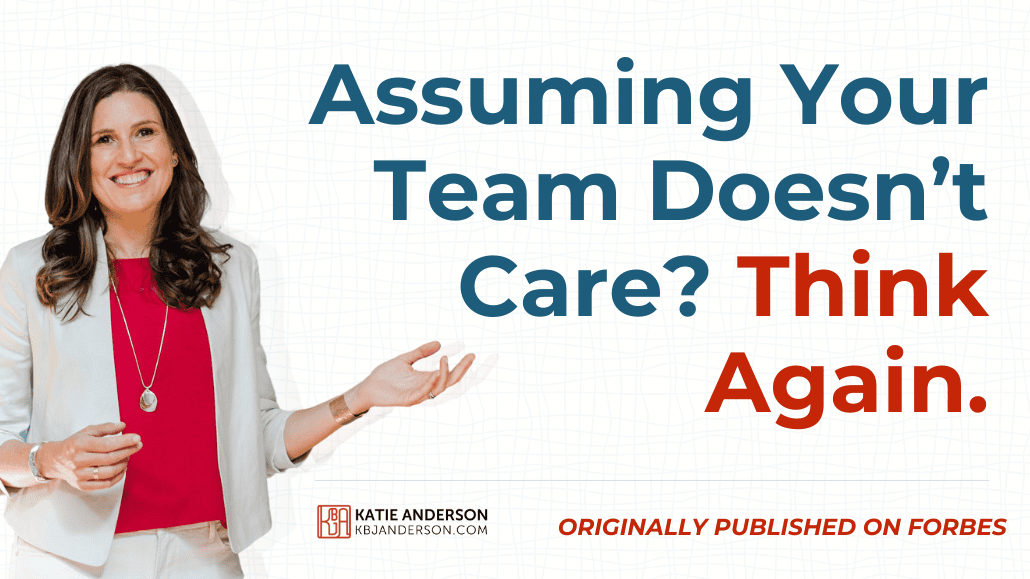A3 thinking for problem-solving is a well-known process in the Lean community, but did you realize that it can be a powerful process for personal development and leadership coaching as well?
Using Personal A3 thinking for problem-solving, and as a coaching tool for developing leaders was the topic of a breakout session I led at the 2016 5th annual Lean Coaching Summit.
Click here to receive a free copy of A3 coaching guide to walk you through the Personal A3 framework!
You can also learn more about using A3 thinking for personal improvement, either as a coach or for your own development, by reading the other posts in this series:
- Coaching for Improvement: Using A3 thinking for personal development – Part 2 – Getting started on the left side
- Coaching for Improvement: Using A3 thinking for personal development – Part 3 – Moving to the “Right Side and Action
This post is intended as an overview of the personal improvement A3 process.
Lean Summit 2016 Breakout Session Highlights
 For the 2016 Lean Coaching Summit, I asked my client and friend Michelle Gabriel to co-present a breakout session with me to dive deeper into the Summit’s theme of “preparation”.
For the 2016 Lean Coaching Summit, I asked my client and friend Michelle Gabriel to co-present a breakout session with me to dive deeper into the Summit’s theme of “preparation”.
We shared how using A3 thinking can help you as a coach not only prepare for coaching sessions but also how the process can better prepare your learner for improvement by increasing their awareness, intention, and ownership of their personal leadership development plan.
Sharing coaching tips with you
My intention in this point is to share some of the key points from our presentation so that you too can continue to practice and deeper your skills as a leader and coach by using A3 thinking for problem-solving, and also for personal development.
“Creating Focus and Intention for Coaching Using A3 Thinking”
A3 thinking for problem-solving
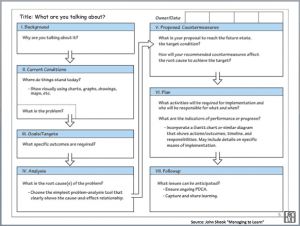
There has been a lot of dialogue in the Lean community about A3 thinking in the past month following two articles that John Shook wrote in the Lean Post with and about his first Toyota manager and mentor (and now mine), Mr. Isao Yoshino. I was inspired by these articles and shared some of my reflections based on prior conversations with Mr. Yoshino in this article – A3 Thinking history and Insights from john Shook and Isao Yoshino in the Lean post.
A3 flow for problem-solving
Made popular by Toyota in Japan as a way to concisely walk through the critical problem-solving steps required to identify and understand a problem and its root causes, and then identify countermeasures and experiments to close the gap between the target and what is happening today.
John Shook describes A3 reports in his book “Managing to Learn” as not just a problem-solving process, but a critical part of a management system. He writes that A3s are:
“… a visual manifestation of a problem-solving thought process involving continual dialogue between the owner of an issue and others in an organization. It is a foundational management process that enables and encourages learning through the scientific method.”
A3 thinking is a skill that can help leaders solve organizational problems and create the foundation of a management system that develops a culture of coaching and problem solving through the structured conversations that occur as part of the A3 development process.
A3 thinking for personal improvement and professional leadership development
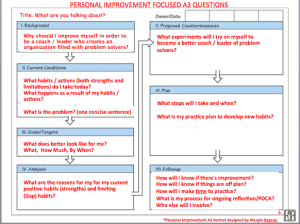
The same A3 thinking process is also one that can help leaders bring greater awareness to their own actions and habits in service to creating an organization filled with problem solvers.
Personal Improvement A3 Flow
When using A3 thinking for personal improvement, the process is the same as a typical problem-solving A3 flow, but the questions are focused inward on the individual.
If a leader is willing to accept the hypothesis that “I am a condition in my organization that requires improvement”, using A3 thinking as a process can be a powerful one.
The flow of thinking in an A3 focused on personal improvement should answer questions such as:
- Why should I improve myself as a leader/coach who creates an organization filled with problem solvers?
- What habits and actions do I currently take today (both strengths and limitations)?
- What are the outcomes of my actions?
- What does a little bit better look like for ME?
- What are the reasons for my current habits and actions?
- What experiments will I try on myself?
- How will I know I’m getting better?
Click here to get a free copy of the personal A3 coaching guide to help you prepare for and coach your learners through the A3 process for leadership development.
Why should I improve myself as a leader or coach?
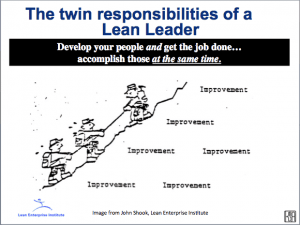
This image is often used as the “anchor” to what it means to be a Lean Leader: getting the job done and developing people – at the same time.
Get the job done
In my experience, many organizations find it easier (especially initially) to focus on the first aspect of the role of a Lean Leader: “getting the job done”.
Senior leaders may decide their organization should undergo a “Lean transformation” to achieve business goals, “to get the job done”. Perhaps they see Lean as a set of tools and production principles to improve processes – or this is easier to focus on initially.
And initially, improvement is often done “off line” through “kaizen events” or other projects, outside of daily work, rather than embedded as part of daily improvement and leadership behaviors.
Develop your people
Achieving business objectives and delivering value to customers is an essential aspect of Lean, but it has to be coupled with developing people as problem solvers at all levels to achieve those business objectives – at the same time.
Leading daily improvement through people development is an essential skill and habit for leaders to develop.
It can be harder to figure out how to develop people – and certainly how to develop people as part of the actual daily work.
But without this critical aspect of Lean leadership practiced by all leaders, we really won’t see a successful Lean transformation of creating an organization filled with problem solvers.
Kaizen and people development in Japan
This emphasis on people development as a means to achieve daily business objectives is one that I saw across my visits to Lean thinking Japanese organizations over the past 18 months – not just Toyota or Toyota’s hospital, but many others (such as this electrical supply manufacturer and this office service manufacturer).
Move from “they need to change” to “I need to change”
An organizational Lean transformation is all about how each of us shows up differently as leaders in service to this goal of “getting the job done” and “developing people” at the same time.
It can be easier to say: “everyone else out there needs to change”, but ultimately, the questions need to be:
- “how do I need to change and improve?” and
- “how do my current habits either support or inhibit the creation of a learning organization?”
The personal improvement A3 process is one way I have found success in helping leaders look at their own actions and help them create a clear plan for practice and improvement.
How do YOU show up as a leader?
We need to look at how we are creating strong habits that support our intention of how we want to lead and coach others. Are our actions and behaviors in line with the problem-solving and respectful culture we want to create?
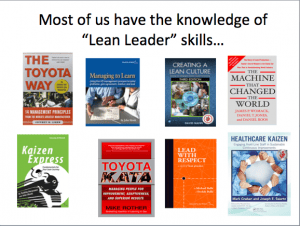
Knowledge and skills are important…
Most of us, and the people we are coaching, have some knowledge of what it means to be a “Lean leader”. We could be new to Lean and just gaining knowledge, or have been practicing these skills for many years.
Some of these essential Lean leader skills include: asking effective questions, listening, and supporting daily improvement at all levels.
… but habits are about how we put knowledge and skills into practice every day.

While we might have knowledge of how we should behave as leaders, we might not always be in the habit of practicing these skills every day.
Or we may have some limiting habits that get in our way of putting our knowledge and skills of Lean leadership in place every day.
For example, a leader may know that asking open-ended questions of inquiry is important, and even demonstrate skill in asking questions in 1-1 meetings, but when going out to the workplace (e.g. for a “gemba” walk, for example) may have the habit of telling everyone what to do are what “I think you should do….”.
Focusing on how to create skills and develop habits is a critical part of leadership development.
Practice and model the skills to create habits

Going through an A3 process focused on yourself (or as a coach helping someone go through the process) can help accelerate the creation of better leadership habits by identifying gaps in skills and putting a plan in place for getting a little bit better every day.
Coaching someone through the A3 process to create their own personal improvement plan also allows an opportunity for you as the coach to model Lean leadership skills (asking effective questions, A3 dialogue, listening, etc.) for the learner while reviewing and advancing the A3.
My personal development
I want to acknowledge my own professional coach and friend Margie Hagene, who introduced the application of A3 thinking to leadership development to me.
Using this process personally has made me a better coach. By answering these questions deeply for myself, I have continued to hone in on what skills and habits I need to keep improving. I am more intentional about how I show up and how I am improving every day as a coach and leader. I use this process in a majority of my coaching relationships, as highlighted in Michelle’s story of improvement at the Coaching Summit.
Learn more
In subsequent posts, I’ll share in more detail how you can coach your learner through each part of the A3 flow for personal development. You can also get the coaching guide we created to support the personal A3 process by clicking here.
Additional references
Interested in more tips and insights about coaching, Lean leadership, and A3 thinking for problem-solving and personal development? You can find more information in some previous articles that I’ve written, including:
On this blog:
- Coaching for Improvement: Using A3 thinking for personal development – Part 2 – Getting started on the left side
- The Power of Practicing Personal Problem Solving
- Coaching for Improvement: not just Lean, Toyota, or Silicon Valley methods….Just good leadership
- Leading Daily Improvement: Creating New Habits and Practices to Support Continuous Improvement
- Effective Questions to Support Problem Solving Thinking
- “Live less out of habit and more out of intent” – Intentions for 2016
In the Lean Post:
- Be More than a Coach, Be a Coach Who Listens
- How To Get Out of the Habit of Telling
- Building Capability, Transforming Organizations
What thoughts do you have on A3 thinking for problem-solving and personal improvement?
Have you tried using a personal improvement A3 process as either a coach or for yourself personally? What has been your experience? Please share your thoughts and questions below.









